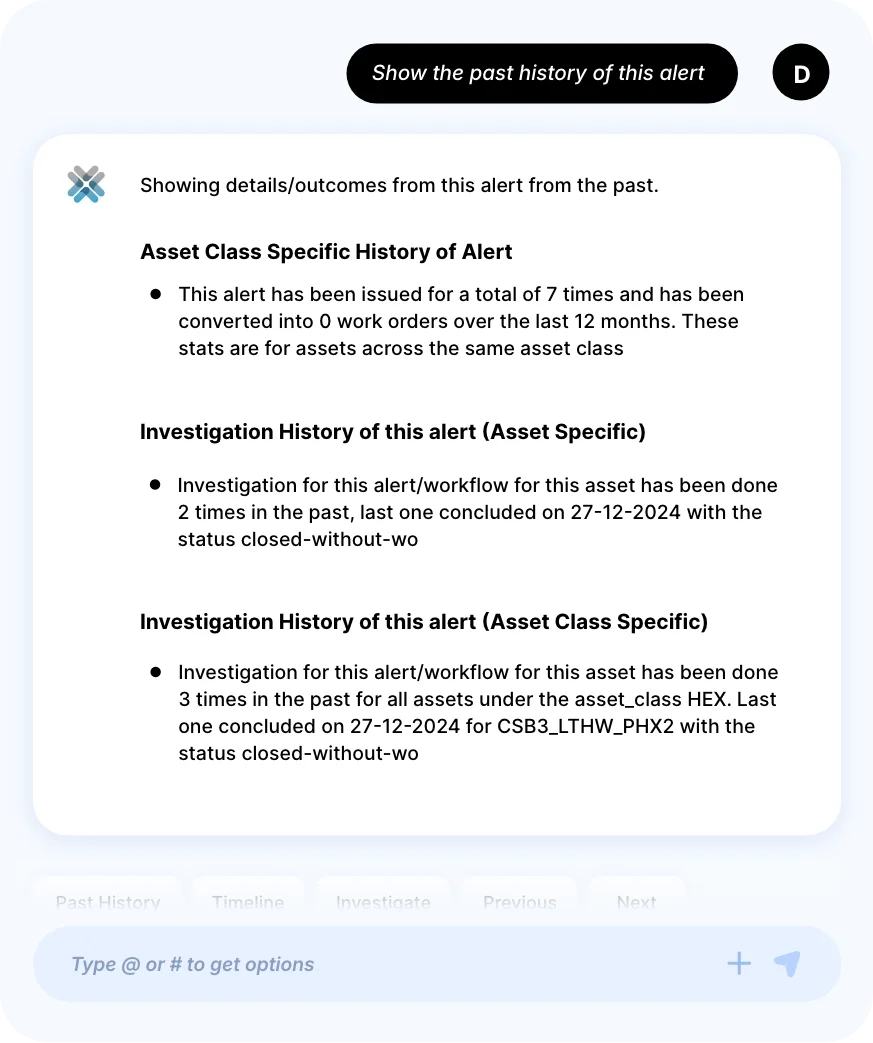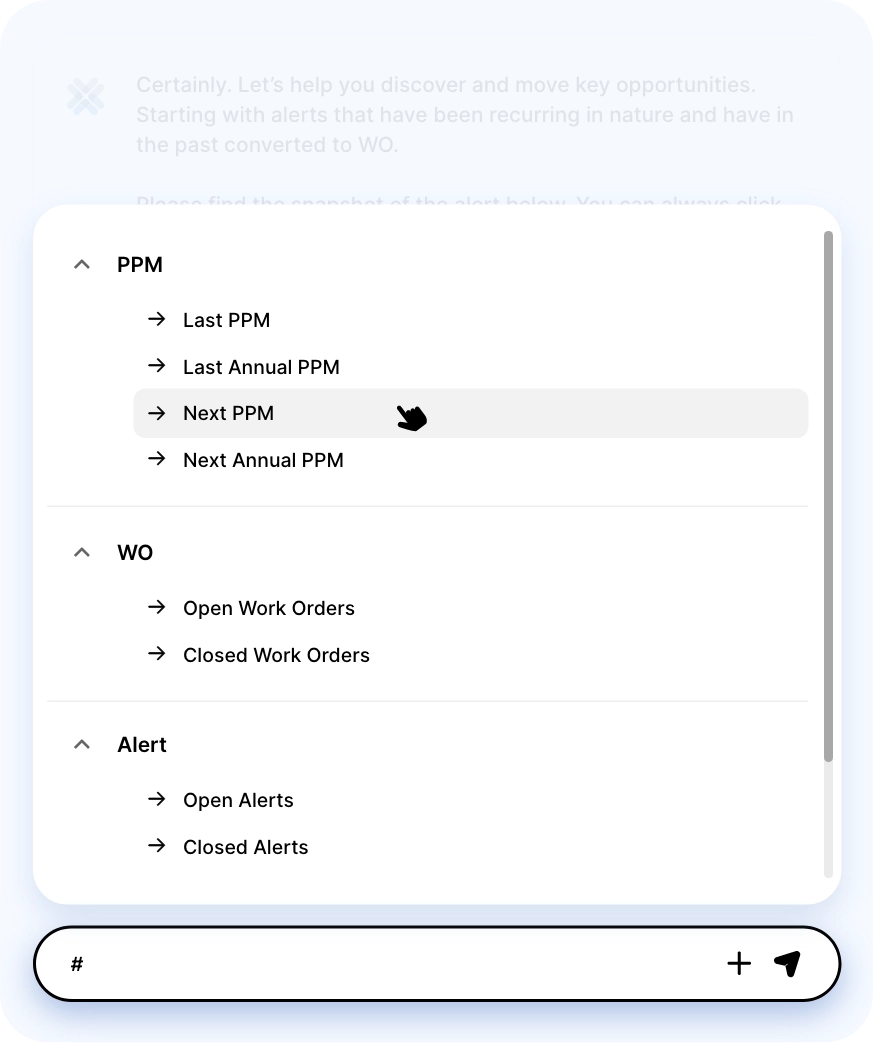AI Agent for Autonomous Fault Detection and Diagnostics
Xempla’s AI Agent employs dynamic FDD logic to minimize false alarms and runs the triaging process autonomously, allowing engineers to focus on problem-solving and complete the loop from fault to fix in record time.
The Problem With FDD Software Today
Current FDD solutions are riddled with inefficiencies and demand a time and resource-intensive model that doesn’t cut it anymore. Instead of enabling proactive maintenance, they slow teams down, create noise, and limit scalability.
Static Thresholds
Traditional FDD systems rely on rigid thresholds, often missing early warning signs or triggering unnecessary alerts, leading to inefficiencies and increased asset wear over time.
Manual Triaging
Engineers must manually assess and prioritize every fault, delaying critical issue resolution and consuming valuable time that could be spent on high-impact maintenance decisions.
False Alarms
Unfiltered alerts flood engineers with excessive noise, making it difficult to distinguish between critical failures and minor fluctuations, leading to missed opportunities for proactive intervention.
Lack of Insights
Limited contextual insights and fragmented data make decision-making unreliable, often resulting in misdiagnosed faults, incorrect work orders, and inefficient maintenance execution.
Reactive Approach
Conventional FDD practices remain disconnected from overall predictive maintenance strategies, forcing teams to address issues only after failures occur, increasing downtime and operational risk.
Limited Scalability
As asset portfolios grow, manual processes make it impossible to efficiently scale FDD operations without overwhelming existing teams or significantly increasing headcount.
Run Advanced Fault Detection and Diagnostics on Autopilot with Xempla
Xempla combines Agentic AI workflows with advanced automation to help engineers run a more efficient, optimized, and accelerated FDD process with minimal supervision.
Cuts out noise by flagging recurring issues vs one-off events
Unlike conventional FDD software and alarm management systems, the Agent’s intelligent FDD layer minimizes false alarms by flagging persistent issues vs ad hoc or one-off events. The result? Fewer tickets. Less fatigue. More focus.

Automates triaging and ranks alerts in order of priority
The Agent automatically reviews, classifies, and prioritizes faults with higher chances of converting to work orders based on factors like severity, impact, recency, and frequency—ensuring critical issues are addressed first while low-priority issues are deferred or dismissed.

Consolidates crucial data points to accelerate root cause analysis
With just a few clicks, engineers can pull up contextual data points required to run high-quality investigations in one centralized interface — no switching between tabs or systems. The Agent can even auto-fetch frequently used information for a specific type of issue to increase accuracy and save engineers even more time and effort during root cause analysis.

Recommends go/no-go decisions on work order generation
Based on the pattern and progress of investigations, the Agent consistently provides engineers with go / no-go recommendations for work orders. Over time, it can completely automate work generation and guide engineers through subsequent steps to close the loop with prompt-based single-click actions.

THE XEMPLA EDGE
Go Beyond and Connect FDD Operations to Bigger Maintenance Outcomes
Xempla transforms FDD into an intelligent, automated workflow that improves asset reliability, enhances resource efficiency, and optimizes maintenance operations at scale.
Autonomous Maintenance
Xempla’s AI-driven fault detection and autonomous triaging enable a seamless, self-operating maintenance workflow that maximizes operational efficiency with minimal human intervention.
Enhanced Decision-Making
AI empowers engineers with real-time insights and context for root cause analysis, with intelligent recommendations enabling faster, more accurate decisions that drive better results.
Improved Asset Reliability
By eliminating false alarms and prioritizing critical issues, Xempla ensures high-impact faults are addressed effectively, preventing failure, reducing downtime, and extending asset lifespan.
Standardized Service Delivery
Ensure each engineer, regardless of knowledge and skill level, follows a standardized process to deliver consistent service quality across multi-site operations and customer satisfaction.
Scalability Without Limits
AI eliminates manual bottlenecks and reduces dependence on individual expertise, allowing you to scale operations effectively while maintaining organizational capacity and competitiveness.
Human Resource Efficiency
With human oversight and physical interventions minimized, engineers and maintenance teams can focus on high-value activities, improving productivity without increasing headcount.
JOIN THE CLUB
Drive World-Class Results.
Just Like Some of Our Leading Customers.
Real results, real impact. Top FM & Engineering Service Companies trust Xempla to deliver the goods—consistently.
Transform Your Maintenance Operations with
AI-Driven Fault Detection and Diagnostics.
Frequently Asked Questions
The Agent’s Fault Detection and Diagnostics layer is designed to flag recurring issues, as opposed to ad-hoc problems. This reduces the number of tickets generated in the first place, which is a significant advantage over typical alarm management systems. This means engineers are not wasting their time with one-off issues and can focus on the causes of repeated incidents to improve the entire workflow.
Yes, the agent can be used with other Fault Detection Diagnostics or Analytics platforms. Most FDD software is strong at finding faults but the investigation and work order generation process is broken. That’s where the agent can help companies leverage the DIIV framework without having to switch or change their FDD solution provider. Given that they would have an FDD solution, there would not be any costs associated with data integration, etc, they could straight away adopt an outcome-driven model and pay per Work Order generated by Xempla.
Given that you have done the most important bit of aggregating data and putting it up on cloud / data lake, Xempla’s Agent would integrate with your data layer, also providing coverage from our own FDD layer, thereby helping you achieve maximum value from your data investments. This is a great way for companies that have invested in central data repositories or independent data layers (IDL).
The Agent enhances maintenance efficiency by automating the initial triaging of tickets, prioritizing high-impact issues, and enabling engineers to focus their efforts on critical tasks. The automation process reduces manual work, allowing engineers to handle more tickets per day. This leads to significant cost savings and better resource allocation across teams, improving overall maintenance efficiency and reducing maintenance costs.
The ROI of implementing the Agent is significant. Automated triaging, faster investigations, and more effective corrective actions increase the value derived from engineering resources and onsite teams. The Agent’s hyper-focused workflows allow engineers to get more (high-impact work) done in less time, while the asset performance and reliability improvements offer additional value. Overall, companies can expect to cut down their cost of maintenance operations by up to 40%.
